A Complete Filmmaking Curriculum
300+ lessons packed with on-set video tutorials taught by Oscar and Emmy-winning filmmakers, illustrated articles, hundreds of downloadable forms, online resources, and much, much more.
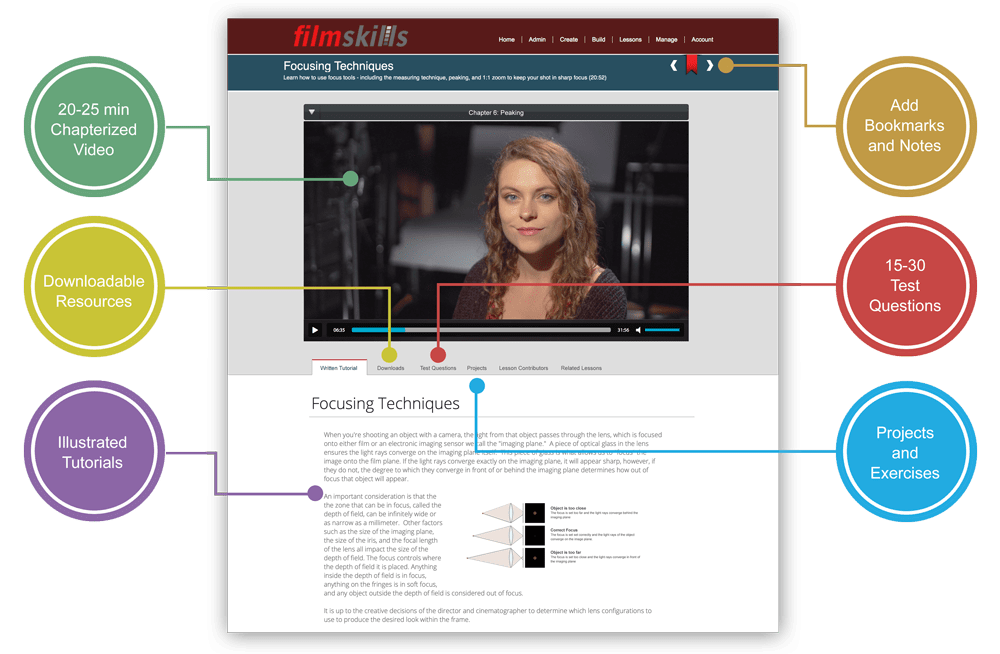
Video Tutorials
Experience every part of the filmmaking process through engaging on-set video tutorials shot on working sets.
Articles
Supplement videos with thousands of illustrated articles on nearly every facet of the filmmaking process.
Downloadables
Download hundreds of real documents from top TV shows and movies, as well as blank templates you can use on your own productions.
Web Links
Connect with industry leading production companies, job boards, vendors, rental facilities, and online resources.
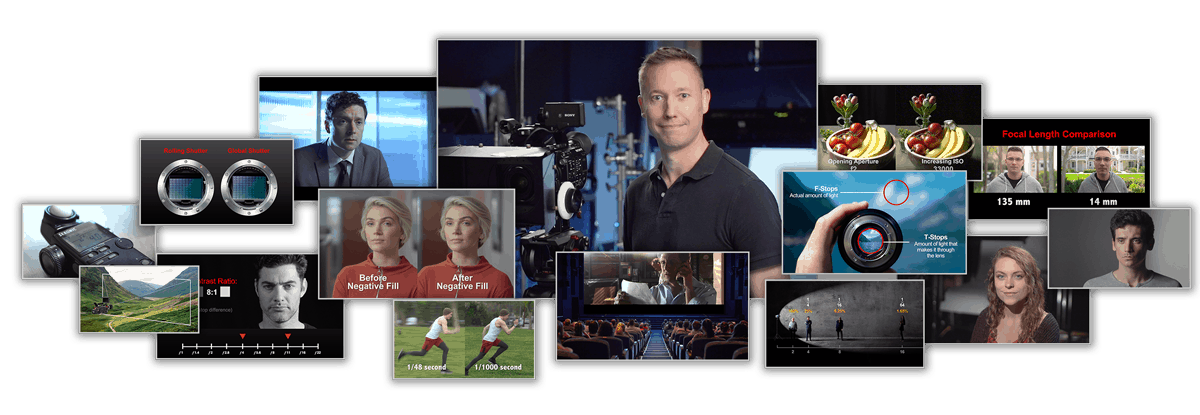
Explore the Lessons
Your academic license includes the following lessons which you can mix and match to create custom learning paths for your students.

This section helps students understand the requirements, challenges, and realities of working in the entertainment industry. Over 150 successful Hollywood filmmakers from all disciplines provide real world advice to help better prepare students for a career after school.
How to Break into the Film Industry | ||
|---|---|---|
Career Advice from the Pros | 21:13 | HS |
How to Get Your First Job | 22:54 | HS |
How to Move to Los Angeles | 18:13 | |
How to Make Money in the Film Industry | 24:37 | |
Realities of a Career in the Film Industry | 27:18 | HS |
The Art of Networking | 22:17 | |
How to Survive in Hollywood | 17:00 | |
Working Freelance | 26:14 | HS |

The core screenwriting curriculum is organized into three stages, with all three guiding the student through the screenwriting process.
- Section 1: Story Structure – this series of lessons focuses on how to build and structure the story, manage sub plots, and how to address story pacing issues.
- Section 2: Character Development – this series of lessons guides students through the process of creating believable characters, developing strong backstories, and writing convincing dialogue.
- Section 3: The writing process – In this section, students learn how to approach the writing process, from outline to rewrites.
Core Screenwriting Curriculum | ||
|---|---|---|
Section 1: Story Structure | ||
Lesson 1 – Beginning the Writing Process | – | |
Lesson 2 – Working with a Writing Partner | – | |
Lesson 3 – Finding Story Ideas and Inspiration | 17:36 | HS |
Lesson 4 – Developing a Marketable Idea | 19:40 | |
Lesson 5 – Story Formats | 17:18 | |
Lesson 6 – The 7 Plot Types | 20:01 | HS |
Lesson 7 – The Implications of Genre | 16:40 | HS |
Lesson 8 – The Three Act Structure | 39:00 | HS |
Lesson 9 – A-Story and Subplots | 27:52 | |
Lesson 10 – Techniques to Improve Story Pacing | 14:40 | |
Lesson 11 – Techniques to Engage the Audience | 23:11 | |
Section 2: Character Development | ||
Lesson 12 – Creating an Amazing Protagonist | 32:08 | HS |
Lesson 13 – Creating the Perfect Antagonist | 23:23 | HS |
Lesson 14 – Conflict Types | 22:33 | |
Lesson 15 – How to Write Memorable Supporting Characters | 18:54 | HS |
Lesson 16 – Understanding Character Archetypes | 24:44 | |
Lesson 17 – Designing Personality and Building Backstory | 29:06 | HS |
Lesson 18 – How to Write Natural Dialogue | 21:46 | HS |
Section 3: The Writing Process | ||
Lesson 19 – Title, Theme, and Log Lines | 15:02 | HS |
Lesson 20 – How to Write a Treatment and Outline | 19:30 | |
Lesson 21 – How to Format a Screenplay | 18:13 | HS |
Lesson 22 – How to Write the First Draft | 10:34 | HS |
Lesson 23 – Techniques for Rewriting and Refining Your Script | 13:55 | |
Lesson 24 – How to Market Your Script to Producers and Agents | 21:18 | |
Lesson 25 – Your Screenplay and the Real World | 17:29 |
Additional Screenwriting Lessons | ||
|---|---|---|
Beginning the Writing Process | – | |
Working with a Writing Partner | – | |
The Changing Landscape of Television | 34:36 | |
Defining and Writing Comedy | 29:36 | |
The Hidden Tools of Comedy | 32:02 | |
How to Become a Hollywood Writer Part I | 10:53 | |
How to Become a Hollywood Writer Part II | 30:12 | |
How to Work in a Television Writers Room | 24:40 | |
How to Write a Reality Television Show | 22:22 |
Working with Final Draft Software | ||
|---|---|---|
Final Draft – Script Basics | 26:05 | |
Final Draft – Using Templates | 13:02 | |
Final Draft – Story Organization | 15:21 | |
Final Draft – Distributing Your Script | 17:37 | |
Final Draft – Tips, Tricks, & Utilities | 28:00 | |
Final Draft – Production | 23:15 |

Students learn the business of filmmaking, with emphasis on the studio and corporate structures, how to raise and manage money, work with unions, and handle the financial aspects of filmmaking.
Producing and Development | ||
|---|---|---|
The Studio System | 33:09 | |
Working for a Studio | 26:19 | |
Making a Business Plan | 30:53 | |
Packaging Your Movie | 29:29 | |
Agents and Managers | 23:37 | |
How to Pitch and Sell a Reality TV Show | 28:54 | |
How to Raise Money for your Movie | 39:30 | |
Taking Advantage of Tax Incentives | 21:54 | |
Forming a Production Company | 32:54 | |
How to Manage the Budget Money | 36:07 | |
Hiring the Crew | 30:31 | |
Working with Vendors | 18:34 | |
Unions and Guilds | 35:40 | |
Working with SAG/AFTRA | 25:47 |

Scheduling and Budgeting | ||
|---|---|---|
Beginning Pre-Production | – | |
Breaking Down the Script | 19:54 | HS |
Scheduling the Production | 33:54 | HS |
Scheduling the Day | 29:48 | HS |
How to Build a Budget | 30:45 | HS |
Production Insurance | 19:45 |
Expansion Lessons |
|---|
How to Use Day-Out-Of-Days Form |
How to Use the Daily Production Report |
How to Use Crew Deal Memos |
How to Create a Call Sheet |
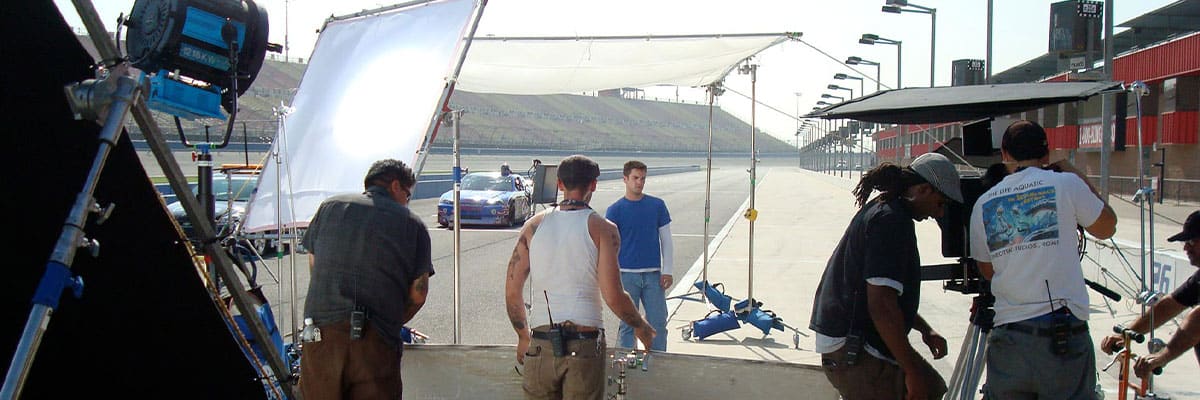
In this series, each lesson focuses on the duties and responsibilities of every major crew position. Students learn the crew hierarchy, what it takes to succeed in each role, and common career paths. In these “virtual job shadows,” working Hollywood filmmakers candidly share their knowledge, experiences, and advice from getting the phone call for a job through completion of a project.
The Crew | |
|---|---|
Crew Structures | – |
Crew Positions | – |
How to Find a Crew | – |
The Line Producer | 35:57 |
The Unit Production Manager | 23:14 |
Production Coordinator | 19:44 |
1st Assistant Director | 2:26 |
2nd Assistant Director | 9:23 |
2nd 2nd Assistant Director | 5:59 |
Production Assistants | 24:15 |
Script Supervisor | 27:01 |
Production Designer | 20:15 |
The Art Director | 11:11 |
Construction Coordinator | 14:55 |
The Construction Crew | 9:28 |
The Cinematographer | – |
Camera Operator | 26:46 |
1st Assistant Camera | 16:47 |
2nd Assistant Camera | 7:33 |
Key Grip | 17:05 |
Best Boy | 12:27 |
Grips | 11:49 |
Working as a Grip | 25:16 |
Dolly Grip | 12:40 |
Gaffer | 19:38 |
Best Boy Electric | 10:30 |
Electricians | 16:36 |
Craft Services | – |
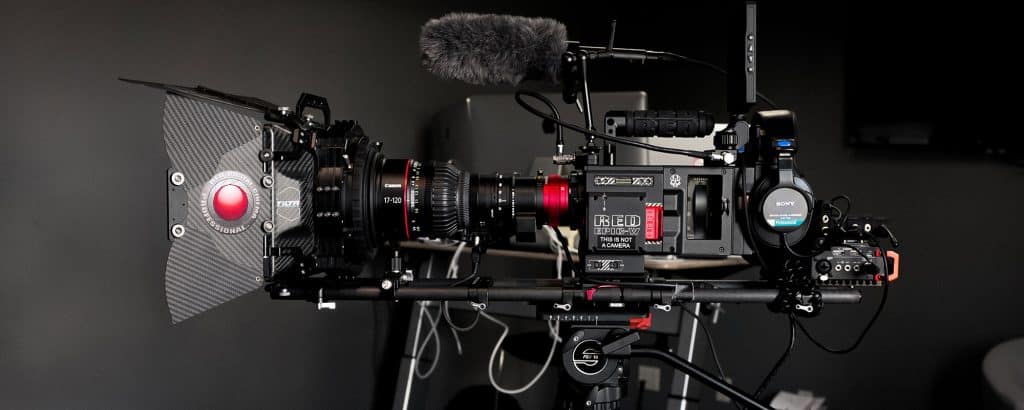
Cinematography | ||
|---|---|---|
An Overview of Cinematography | – | |
How a Cinematographer Preps a Project | – |
Camera and Lens | ||
|---|---|---|
Building the Camera Package | – | |
How to Prep a Camera | 14:37 | |
Imaging Sensor and ISO | 20:25 | HS |
Frame Rates | 20:02 | HS |
Film vs Video | 26:57 | |
Tripods and Sliders | 17:58 | HS |
Introduction to Lenses | 22:00 | |
Lens Care | 9:28 | |
Focusing Techniques | 23:21 | HS |
How to Expose a Shot | 25:16 | HS |
F-stops and T-stops | 17:42 | HS |
The Zone System | 23:03 | |
Lens Focal Length | 23:50 | HS |
Depth of Field Tutorial | 27:29 | HS |
Macro Focus | 9:28 | |
Back Focus | 4:51 | |
The Shutter | 12:54 | HS |
Managing Your Media | – |
Framing and Composition | ||
|---|---|---|
Composing the Frame | 21:48 | HS |
Creating Depth in the Frame | 17:20 | HS |
The Actors’ Eyelines | 9:26 | HS |
Framing People | 17:19 | HS |
The Rule of 180 and Screen Direction | 24:32 | HS |
Shot Types | 28:07 | HS |
The Technicalities of the Frame | 13:15 | HS |
Using a Clapboard | 11:04 | |
Using a Light Meter | 12:34 | |
Using a Production Monitor | 14:29 |
Lighting | ||
|---|---|---|
Introduction to Light and Exposure | 23:27 | HS |
Attributes of Light | 34:02 | HS |
Tungsten Lighting | 11:01 | |
HMI Lighting | 20:02 | |
Kino-Flo Fluorescent Lighting | 14:02 | |
LED Lighting | 7:10 | |
How to Build a Light Kit | 15:31 | HS |
Low Budget Lighting Tools | 9:37 | |
Reducing Light | 26:43 | HS |
Softening Light | 26:50 | HS |
Working with Reflected Light | 19:18 | HS |
Shaping Light | 23:53 | HS |
Color Temperatures | 26:22 | HS |
Lighting a Scene | 24:42 | |
Lighting Daytime Exteriors | 23:10 | HS |
Working with Mixed Light | 22:32 | |
Lighting People | 23:36 | HS |
Three Point Lighting | 21:28 | HS |
Key Light Techniques | 26:56 | |
Advanced Lighting Techniques | 17:44 | |
Green Screen Techniques | 25:22 | HS |
Lighting Demo – Kitchen Counter Daytime | 19:14 | |
Lighting Demo – Bedroom Dialogue Scene – Nighttime | 23:19 | |
Lighting Demo – Bedroom Daytime | 20:19 | |
Lighting Demo – Bathroom Daytime | 24:22 | |
Lighting Demo – Living Room Nighttime | 12:34 | |
Lighting Demo – Kitchen Table Daytime, Part I | 19:59 | |
Lighting Demo – Kitchen Table Daytime, Part II | 13:20 | |
Lighting Demo – Living Room Morning | 16:21 | |
Lighting Demo – Dining Room Nighttime | 23:04 |
Grip and Rigging | ||
|---|---|---|
C-Stands | 17:59 | |
Clamps | 23:36 | |
Dolly and Track | 12:54 | |
Grips Tools | 9:20 | |
Grip Rigs | 19:09 | |
Grips Support | 8:02 | |
Knots for On Set Rigging | – | |
Rigging | 17:59 | |
Stands | 16:38 |
Expansion Lessons |
|---|
Working with Waveform Monitors |
Working with LOG Footage – an Introduction |
How LOG Footage is Encoded |
Working with LOG Footage – How to Shoot LOG |
LUTs and How to Use Them |
Prepping the Camera for a Walkaway |
Working with a Follow Focus |
Working with a Follow Focus |
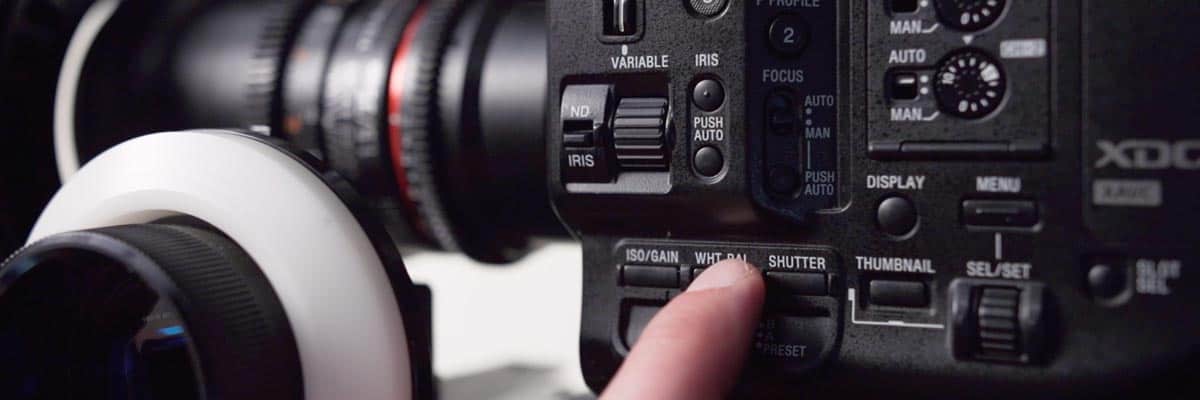
Quick Start lessons have been specifically designed for non-technical students such as acting or screenwriting students. These lessons guide students through basic camera functions, audio recording, and production techniques to alleviate pressure from the instructor when assigning student projects requiring school equipment.
Each lesson includes a downloadable and printable quick start guide to help students on set.
Quick Start Lessons | ||
|---|---|---|
Setting Up Your Camera | 12:36 | HS |
Basic Shooting Techniques | 16:56 | HS |
Basic Framing Techniques | 16:27 | HS |
Basic Audio Techniques | 15:21 | HS |
Basic Production Techniques | 15:51 | HS |

The directing curriculum has been divided into two sections. The first focuses on the director/actor dynamic and provides tools for students to communicate with actors, determine underlying motivations and subtext, and techniques for getting the performance they want.
The second section focuses on the director’s craft, focusing on how to shoot a scene, blocking and coverage techniques, and how to prepare for a day on set.
Casting | ||
|---|---|---|
Finding Actors & Casting Directors | 23:43 | |
Auditions | 27:35 | |
Callbacks | 12:44 | |
The Art of Auditioning | 18:38 | |
Working with Local Celebrities | 15:46 |
Directing Actors | |||
|---|---|---|---|
Analyzing Character | 30:19 | ||
Rehearsing with Actors | 26:47 | ||
Rehearsing Exercises | 12:49 | ||
The Language of Directing Actors | 34:07 | HS | |
Acting in a Changing Industry | 19:48 | ||
Acting Techniques | – | ||
Acting Techniques for the Screen | 28:33 | ||
How to Direct Actors on Set | 38:28 | HS | |
Common Directing Mistakes and How to Avoid Them | 21:20 | ||
How to Direct Background Extras | 24:35 | HS |
The Directors Craft | ||
|---|---|---|
A Director’s Prep– Beginning a New Project | 27:17 | HS |
Developing the Visual Look of Your Movie | 38:22 | |
A Day as a Director | – | |
How to Shoot a Scene | 33:55 | HS |
How to Direct a Scene | 31:00 | HS |
Blocking Actors | 33:11 | HS |
Basic Coverage | 21:45 | HS |
Advanced Coverage | 25:54 | |
How to Direct a Chase Scene | 21:39 | |
How to Create Invisible Camera Moves | 25:42 | |
Storyboards and Pre-Visualization | 30:47 | HS |
How to Create a Shotlist | 17:41 | HS |
Continuity and Script Notes | 22:12 | |
Working with the Military | 20:23 | |
Reality Show Interview Techniques | 25:00 |
Expansion Lessons |
|---|
Factors to Consider When Planning Moving Shots |
Shooting the Rehearsal |
Setting Actor’s Marks |
How to Shoot Car Scenes |

Production Design | ||
|---|---|---|
The Art Department | 29:54 | HS |
How to Design a Set | 25:28 | HS |
Set Construction – Building Your Set | 35:15 | HS |
How to Dress Your Set | 33:16 | HS |
Creating the Look of the Environment | 32:10 | |
Props | 36:16 | HS |
Tour a Prop House | 6:08 |

Shooting on Location | ||
|---|---|---|
Scouting Locations | 18:51 | HS |
Film Commissions | 25:49 | |
Working with Location Owners | 34:02 | HS |
Shooting on a Studio Backlot | – | |
Film Permits | 24:33 | |
Location Tech Scouting | 26:03 | HS |
Community Relations | 26:41 | HS |
Expansion Lessons |
|---|
How to Use a Location Agreement |
How to Use a Location Release |
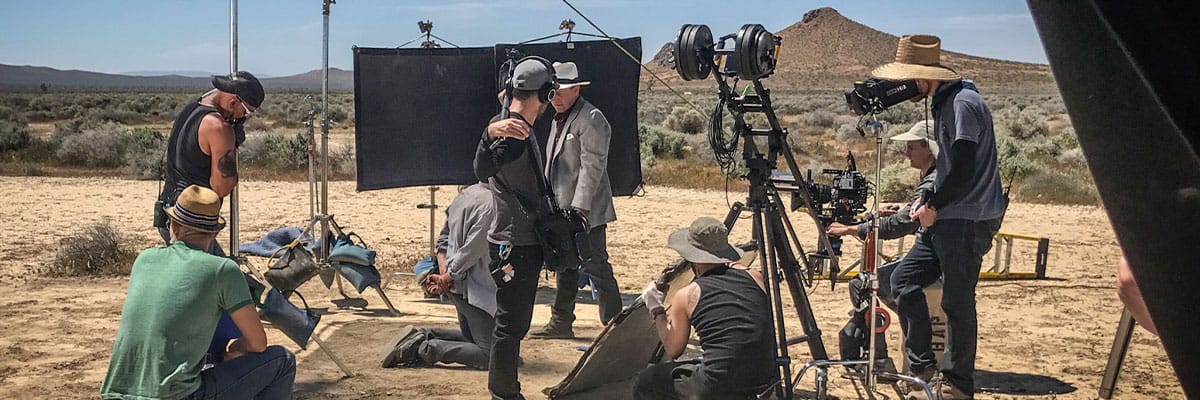
Production Life | ||
|---|---|---|
What to Bring to Set | 9:31 | |
Filmmaker’s Toolkit | 10:40 | |
Proper Set Etiquette and Behavior | 15:44 | HS |
Working with Difficult Personalities | 22:56 | |
Walkie Talkie Etiquette | 14:59 | |
A Day on Set | – |

Audio Recording | ||
|---|---|---|
The Physics of Sound | 26:01 | HS |
How Microphones Work | 23:52 | |
Microphone Pick-Up Patterns | 19:10 | |
Audio Pre-Production | 24:52 | |
Lavalier Microphones | 20:33 | |
The Microphone Boom | 19:09 | HS |
Boom Operating Techniques on Set | 23:02 | HS |
How to Record Audio on Location | 28:17 | HS |
Recording the Audio | 37:58 | |
Audio Configurations | 23:35 | |
Working with Cables and Adapters | 21:16 |
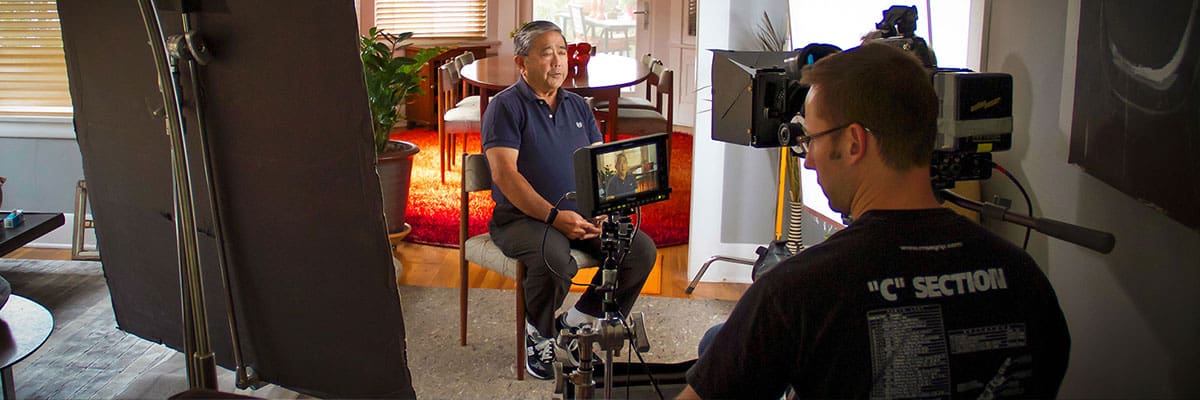
Documentary Filmmaking | ||
|---|---|---|
The Documentary Format | 17:05 | HS |
Documentary Story-Telling Tools | 23:01 | HS |
Finding the Story | 24:50 | HS |
Documentary Pre-Production | 18:51 | |
Choosing the Right Gear | 32:08 | |
Finding the Interview Location | 18:53 | |
Interview Camera Set-Ups | 25:05 | HS |
Preparing for the Interview | 33:03 | HS |
How to Conduct an Interview | 32:05 | HS |
Ethics and Objectivity | 21:37 | |
How to Shoot Amazing B-Roll Footage | 21:52 | HS |
Field Shooting Techniques | 20:17 | HS |
Editing a Documentary | 28:41 |
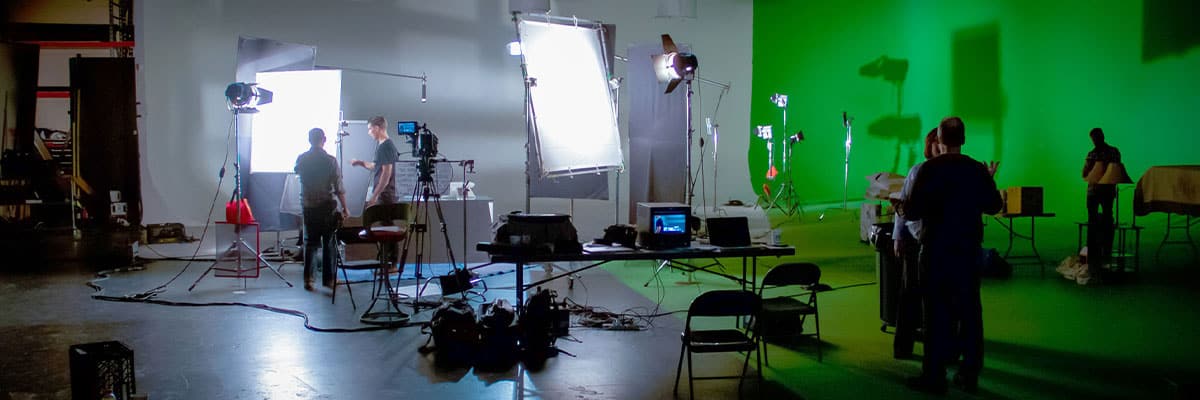
The FilmSkills Safety Training program has been modeled after California’s Safety Pass program and features many of the Safety Pass instructors. Designed to improve student safety and reduce your school’s liability, this comprehensive curriculum covers most major safety issues students will encounter.
Safety Training | |
|---|---|
The Attitude of Safety | 20:27 |
Basic On Set Safety | 34:55 |
On Location Safety | 18:51 |
Studio Facilities Safety | 19:42 |
Vehicle and Roadway Safety | 16:37 |
Shooting Moving Vehicles | 20:12 |
Lighting Equipment Safety | 24:23 |
Grip and Rigging Safety | 25:34 |
Electrical Safety I | 32:19 |
Electrical Safety II | 28:20 |
Lifts, Trucks, and Tools | 18:49 |
Weapon Safety | 25:13 |
Pyrotechnics and Special Effects | 23:51 |
Environmental Safety | 27:27 |

This series of lessons provide students with an inside look into the technical and artistic process of the post production process. Lessons cover data management and workflow, working with producers and clients, the art of the edit, plus the process of audio mixing and scoring.
Editing | ||
|---|---|---|
Introduction to Editing | – | |
Hiring an Editor | 11:35 | |
Working with an Editor | 22:21 | |
Psychology of Editing | 29:10 | HS |
Data Management and Workflow | 20:32 | HS |
The Assembly Cut | 19:28 | HS |
Stock Footage | 20:58 | |
How to Shoot and Edit a Dialogue Scene | 28:57 | |
How to Shoot and Edit Action | 19:49 | |
The Rough Cut | 19:42 | HS |
Test Screenings | 24:18 | |
The Fine Cut | 16:01 | HS |
Online and Offline Editing | 7:46 | |
Color Grading | 25:53 | |
Understanding Compression | – |
Audio Post-Production | ||
|---|---|---|
Intro to Audio Post Production | 24:49 | HS |
ADR | 30:31 | |
Directing Actors in ADR | 28:19 | |
Foley | 33:33 | |
Sound Effects | 24:49 | |
Mixing the Audio | 31:18 |
Music Composition | ||
|---|---|---|
Emotion Through Music | 28:25 | HS |
The Who and How of Music | 31:29 | HS |
Working with a Composer | 47:33 | |
Music Licensing | 33:15 |

This section exposes students to the marketing and distribution process and can be paired with the producing and screenwriting lessons. This series of lessons is intended to demystify the distribution process and help student understand the business of filmmaking, what distributors are seeking, and how to identify and reach the target audience.
Film Marketing | ||
|---|---|---|
Film Marketing | 15:41 | |
Reaching Your Audience | 26:05 | |
Designing the Key Art | 16:11 | |
Making a Movie Trailer | 27:23 | |
Building Your Website | 5:43 | |
Building a Press Kit | 13:35 | |
Working with the Media | 17:56 |
Distribution | ||
|---|---|---|
Introduction to Distribution | 32:55 | |
Film Ratings and the MPAA | 14:09 | |
Domestic Distribution | 23:32 | |
Foreign Distribution | 37:19 | |
Mistakes Filmmakers Make at Film Festivals | 30:05 | |
Film Festivals | 26:46 | |
Online Distribution | 27:34 |
325+ On-Set Video Tutorials
The heart of the FilmSkills curriculum is the ever-growing video library, in which top Academy and Emmy Award winning filmmakers show your students the process of filmmaking. Each video is fully chapterized and can be assigned whenever you want.
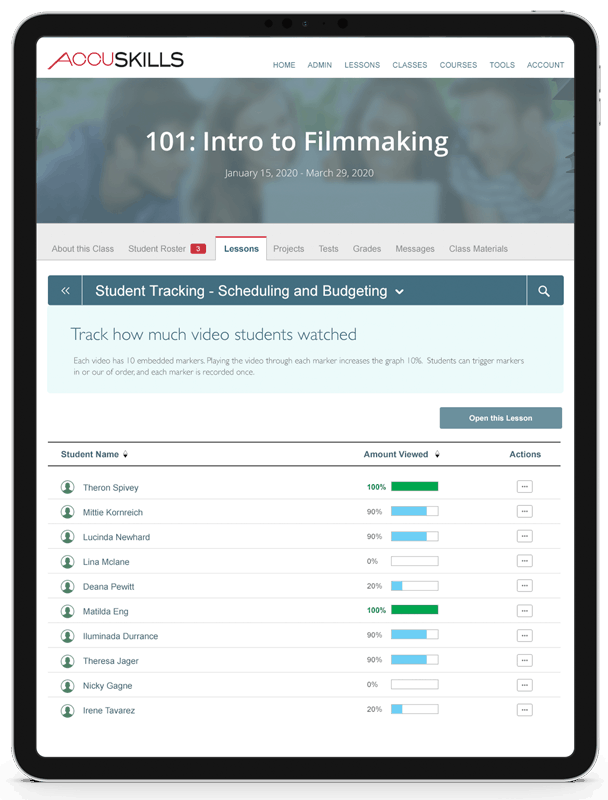
- Over 300 videos covering the entire filmmaking process
- Each video averages 25 minutes long
- Featuring over 70 Academy Award and Emmy winning filmmakers
- Show students production processes you can't demonstrate in the classroom
- Fully chapterized, so you can easily navigate each video
- Includes embedded tracking to monitor student viewership
- Videos are constantly updated with the newest information

Includes 4000 Test Questions
You read that right. Our academic team scrutinized each lesson and wrote a library of test questions so you wouldn’t have to. With our advanced testing tool, you can mix and match questions, add your own, and customize a test in under a minute.
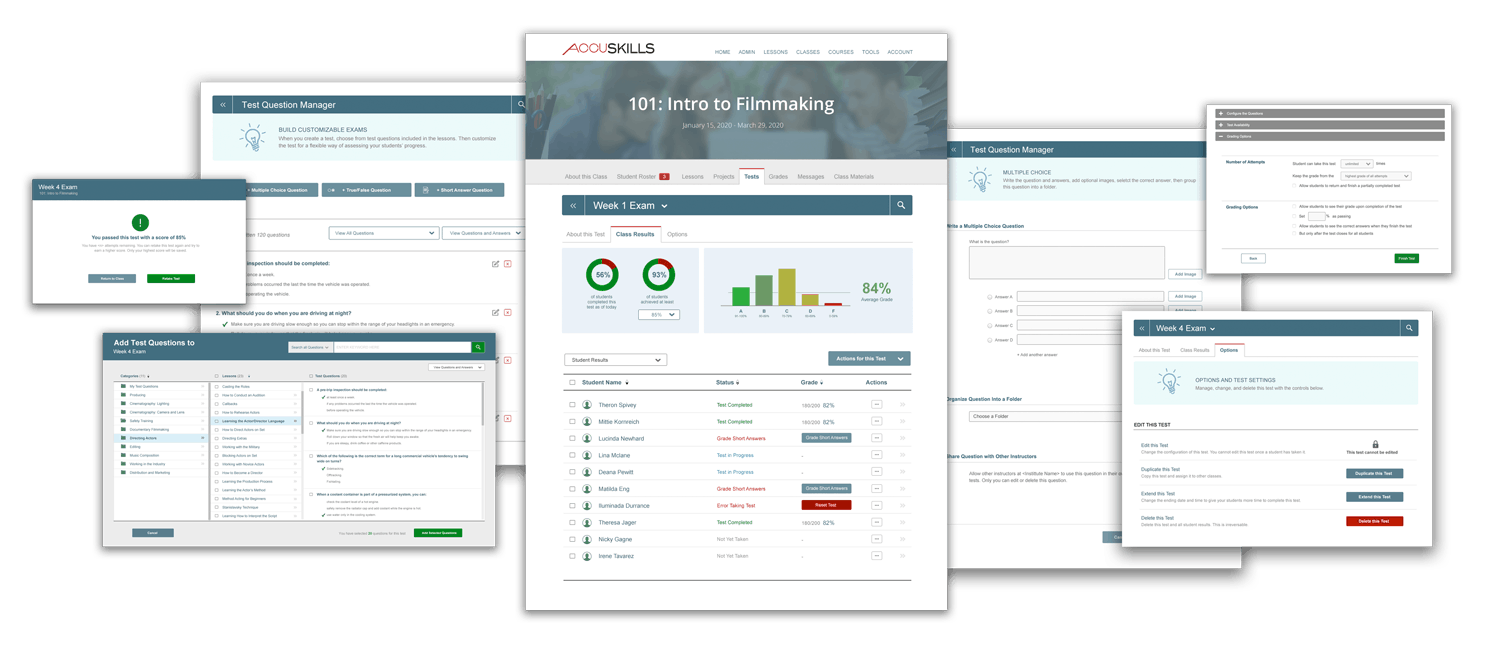
- Multiple choice, true/false, and short answer questions
- You have the option to filter out short answer questions
- Tests are auto-graded for instant results
- Set a test window, duration, and randomization options
- Mix and match test questions from multiple lessons
- Set the number of attempts and passing grade
- Full reporting for class and individual student results
- Grading tool to efficiently manage short answer questions
- Perfect for large group instruction
- Auto-notifications if a student has a problem during the test
Includes Hundreds of Projects and Exercises
We’ve crafted hundreds of hand-on exercises designed to help students apply and practice the skills they learned through the FilmSkills lessons. With our advanced platform tools, students can submit the results which you can grade and provide feedback instantly.
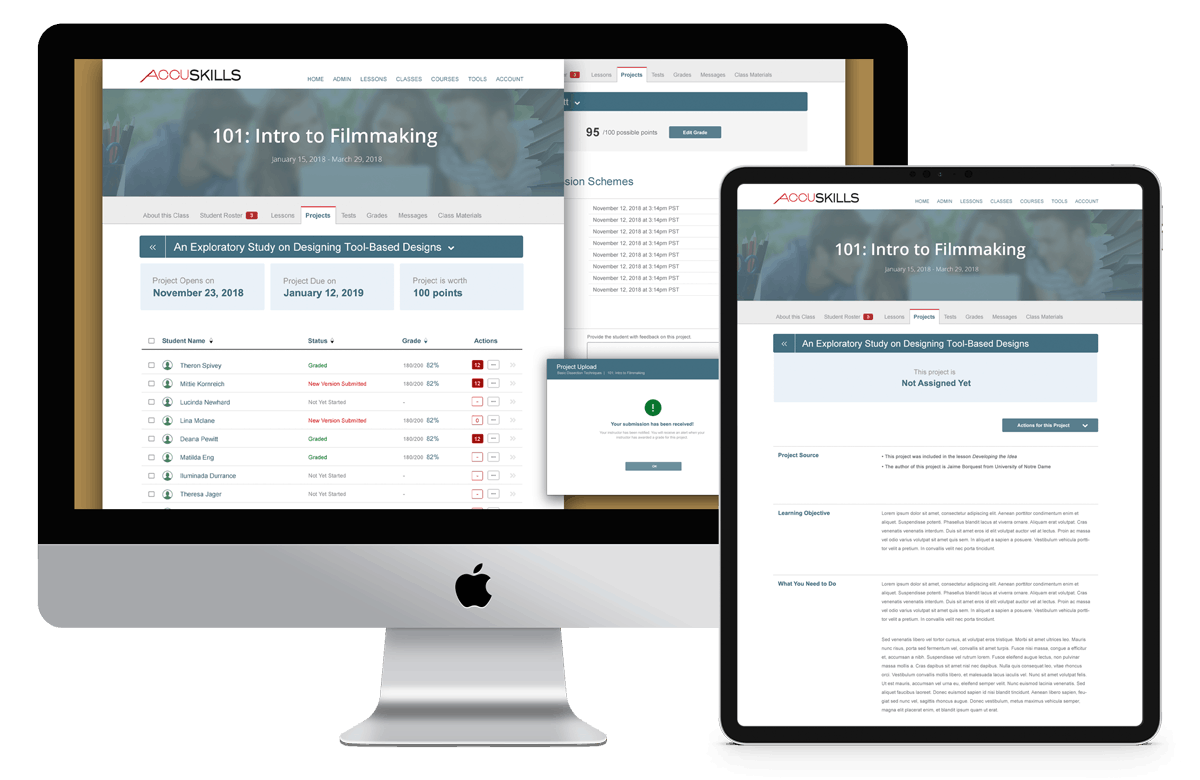
- Projects are academically designed around lesson content
- Includes hundreds of projects you can assign to students
- Author your own projects to work with the FilmSkills projects
- Share your projects with other instructors
- Assign and administer projects on specific dates
- Students can complete and submit projects through the platform
- Grade projects and provide instructor feedback
- Project grades are automaticaly added to GradeBook
Downloadable Forms and Templates
Students can download hundreds of industry-standard templates and forms for use on their own productions, including actual examples from working Hollywood productions which allow your students can see how the pros do it.
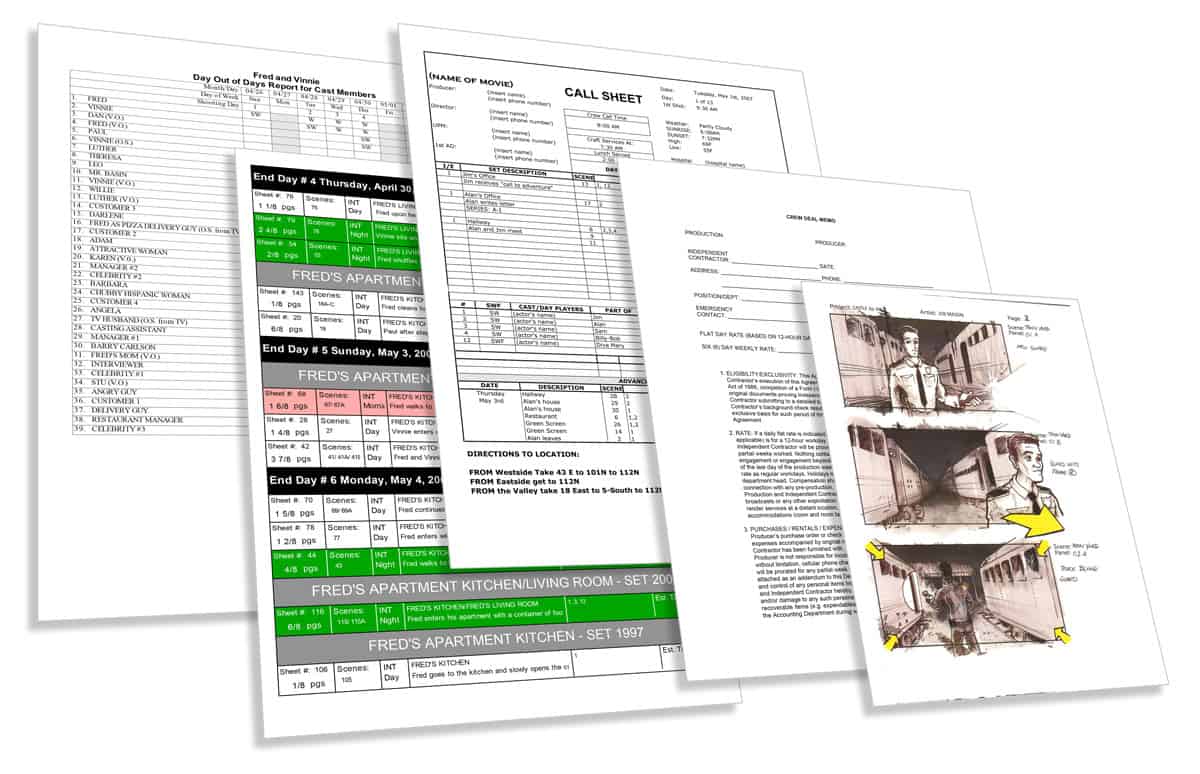
Add FilmSkills To Your Curriculum
Over 80 schools and film commissions have used FilmSkills to enhance their curriculum and better prepare their students for a life in the film industry. Discover how affordable FilmSkills Academic is.

